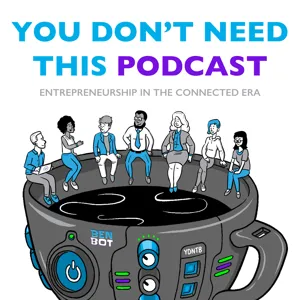Podcast Summary
The intersection of blockchain and AI is leading to advancements in web 3.0 through platforms like NEAR.: NEAR is a blockchain operating system simplifying web 3.0 for developers and users, enabling them to build and use apps without worrying about complexities, and exploring possibilities at the intersection of AI and blockchain.
The intersection of blockchain technology and AI is leading to significant advancements, particularly in the form of a democratized web 3.0 through platforms like NEAR. Ilya Polosukin, co-founder of NEAR and co-author of the Transformers paper, shared his experience in the development of transformers and how it led him to co-found NEAR with the initial mission of teaching machines to code. However, they encountered issues with paying their global workforce, leading them to explore blockchain as a solution. NEAR then evolved into a blockchain operating system aimed at abstracting the complexities of web 3.0 for developers and users, enabling them to build and use applications without worrying about underlying implementations. The overlap between AI and blockchain is most evident in marketplaces for resources, but there are also intriguing possibilities in areas like content authenticity and the alignment problem in AI, which Ilya believes is more of a human problem than a technological one.
Revolutionizing Industries with AI and Blockchain: AI and blockchain integration can create new economic agents, streamline organizational structures, and lead to the emergence of AI-run organizations, revolutionizing industries and creating new opportunities.
The integration of AI and blockchain technology has the potential to revolutionize various industries, particularly in creating new economic agents and streamlined organizational structures. AI agents, equipped with blockchain accounts, can communicate directly with people, task them with work, and provide context, eliminating the need for intermediaries. This could lead to the emergence of organizations run entirely by AI, where an AI agent takes on the CEO role and manages tasks and teams based on specific KPIs and missions. In complex industries like biotech cancer research, this integration could streamline information propagation, task allocation, and funding, leading to more efficient and effective research. Additionally, AI agents providing on-the-job feedback to employees may be more comfortable and objective for employees, potentially leading to the first instances of AI as CEOs appearing in DAOs. Overall, the combination of AI and blockchain technology has the potential to transform the way we work and organize, creating new economic opportunities and more efficient processes.
Revolutionizing Human Organizations with AI and Blockchain: AI and blockchain integration can streamline operations, mitigate misinformation, and prioritize human alignment in DAOs through Web 3 technologies.
The integration of AI and blockchain technology has the potential to revolutionize the way we manage and align human organizations, particularly in the context of decentralized autonomous organizations (DAOs). However, it's important to note that human alignment should be prioritized over AI alignment, as misinformation and malicious actors have long been a problem in human societies. Web 3 technologies, such as cryptography and identity systems, can help mitigate these issues by providing authentication, verification, and reputation management. Automation of onboarding processes and tasks through AI can also help streamline operations in DAOs. Ultimately, a systematic approach is needed to effectively implement these technologies and ensure trust and transparency within decentralized communities.
The Future of Digital Identity with Blockchain: Blockchain's cryptography and smart contracts enable financial transactions, but a more extensible model is needed for social interactions. Lack of critical mass in applications is hindering adoption, but advancements in US expected in coming year.
The future of digital identity lies in blockchain technology. Blockchain's use of cryptography and smart contracts enables programmatic interactions and the addition of intelligence to financial transactions. However, a more extensible model is needed for social interactions and communication. Currently, the lack of critical mass in applications using blockchain-based identity is hindering its widespread adoption. Comparably, SSL faced similar challenges before becoming a default. The integration of blockchain in social interactions and communication is essential for it to become the core identity system. The potential failures in growing capabilities of AI could be mitigated through reputation systems and content provenance on the blockchain. In the coming year, the US is expected to see significant advancements in this area, with both malicious and non-malicious actors experimenting with new technologies.
The Blurred Lines Between Reality and AI: As technology advances, AI and deepfakes pose new challenges for individuals and law enforcement, requiring authentication and verification systems, cryptography integration, and potential overlap with blockchain technology.
As technology advances, the lines between reality and artificial intelligence are becoming increasingly blurred, leading to new challenges for individuals and law enforcement. On the one hand, there's the potential for hyper-focused marketing of political candidates based on user interests, as well as the use of AI-generated content and deepfakes in media. On the other hand, there's the growing threat of malicious use of these technologies, such as deepfakes for consumer fraud and criminal activities. The need for authentication and verification systems, as well as the integration of cryptography into systems, is becoming increasingly important to prevent these issues. Additionally, there's potential for overlap between the blockchain and AI worlds, particularly in the area of GPU capacity for training models and the possibility of training models in a distributed way across a blockchain. However, there are challenges to effectively utilizing the GPUs for AI training and the older models used for mining may not be ideal for this purpose.
Decentralized Inference: A Realistic Application of AI Workforce Solutions: Decentralized inference allows for privacy, scalability, and cost-effectiveness in AI model predictions, utilizing decentralized marketplaces and tokens for payment and quality control.
While decentralized training for large AI models is still a work in progress due to the high bandwidth requirements and challenges with coordination, decentralized inference is a more realistic and needed application. Inference, which involves running AI models on data to make predictions, requires significant compute power and can benefit from decentralized solutions for privacy, scalability, and cost-effectiveness. Decentralized marketplaces, such as those using tokens for payment, can open up the market to a global workforce and provide quality control and escrow services, benefiting both those providing tasks and those doing the work. However, the quality control problem for annotation in decentralized marketplaces can be challenging due to the need for domain expertise and ensuring accuracy. Centralized solutions, while effective for some organizations, may not offer the same benefits and flexibility as decentralized models. Overall, the future of AI workforce solutions lies in a balance between centralized and decentralized approaches, leveraging the strengths of each to address the unique challenges and opportunities in the field.
Challenges for decentralized services vs centralized services: Decentralized services face unique challenges, including high overhead costs for infrastructure and talent acquisition, while left stream marketplaces leverage economic game theory and self-evaluation for high-quality work.
Decentralized services, such as a developer platform using language models for fine-tuning on code, face significant challenges when compared to traditional centralized services. Centralized services require setting up subsidiaries, hiring and training employees, and building validation tooling, leading to high overhead costs. In contrast, left stream marketplaces, where students can join and work on tasks without contracts, offer incentives for high-quality work through economic game theory and self-evaluation. NEAR, a company that approaches innovation through both internal development and external partnerships, is excited about the future of Web 3 and AI, particularly the integration of existing Web 2 projects into the open web and the potential replacement of SaaS with more composable solutions. The transformation of Web 2 projects into Web 3 platforms opens up new economic opportunities and access to innovative technologies, creating a more open and composable digital ecosystem.
AI-driven interfaces for business operations: The future of business operations will involve a hybrid model of traditional UIs and agent-driven interfaces, optimized by transformer architecture, for more efficient and personalized interaction with business processes.
The future of business operations and tooling is moving towards a more dynamic, AI-driven world, where users can describe business processes and have interfaces generated for them based on specific use cases. This shift will bring about a hybrid model of traditional UIs and agent-driven interfaces, allowing for more efficient and personalized interaction with business processes. The optimization and simplicity of transformer architecture are currently leading the way in this space, but challenges remain in improving model capacity and ensuring data sets are clean and accurate. Ultimately, this evolution will bring about a more flexible and dynamic work environment, where users can delegate tasks to AI and receive results in a more natural and integrated way.
Exploring transformer architecture improvements for complex tasks: Transformer architecture can be enhanced by allowing empty tokens and varying output time for deeper thinking, but current silicon optimization and economies of scale make it difficult for alternatives to emerge.
There is a need to expand upon current transformer architecture for more complex tasks, such as critiquing answers or thinking before outputting, which can be achieved by allowing for empty tokens during training and varying the time given for output at inference. This approach can help the model think more deeply and maintain semantics, as opposed to relying on searches at inference time. However, the transformer architecture's effectiveness on current silicon and the significant optimization work being put into it create a lock-in effect, making it difficult for other approaches or architectures to emerge as viable alternatives in the near future. The discussion also touched upon the example of an alternative silicon that allows for data processing in pipelines but doesn't fit transformers well, making it challenging for companies using this technology to compete with the economies of scale that Nvidia currently enjoys. In essence, the focus for now is on optimizing current silicon and exploring combinations of existing technologies, with the possibility of new innovations emerging in the future.
Technological lock-in between compute architecture and machine learning models: The strong interdependence between hardware and machine learning models is making it difficult for new innovations to disrupt the market, but the demand for more efficient and powerful hardware may eventually lead to a breakthrough
The strong mutual reinforcement loop between underlying compute architecture and machine learning models is creating a technological lock-in, similar to the Windows and Intel monopolies of the nineties. This lock-in makes it difficult for new innovations to disrupt the market, especially when it comes to full stack optimization like NVIDIA's CUDA investment. However, the demand for GPUs to meet the growth of applications, particularly inference needs, is creating a supply imbalance that may incentivize the development of heterogeneous hardware to catch up. With every large company developing their own hardware accelerators and the market becoming saturated with them, it remains unclear if heterogeneous hardware can match the full stack optimization of market leaders like NVIDIA. The future of the market is uncertain, but the past 18 months have seen a shift in incentives for companies to pursue heterogeneous hardware, and this trend is expected to continue with the release of new hardware accelerators this year and next. Overall, the technological lock-in between compute architecture and machine learning models is creating a challenging landscape for innovation, but the demand for more efficient and powerful hardware may eventually lead to a breakthrough.





